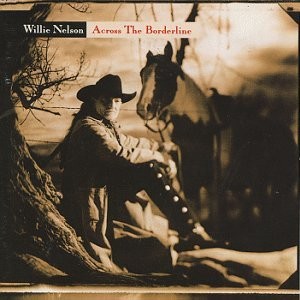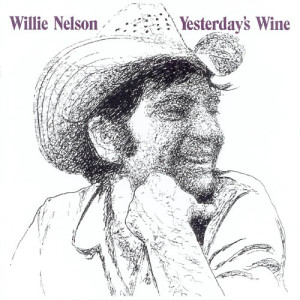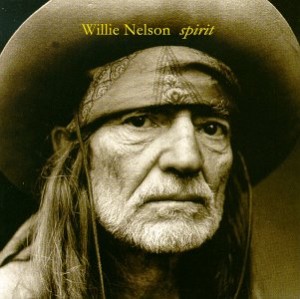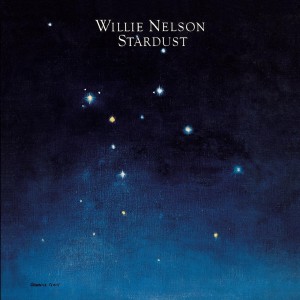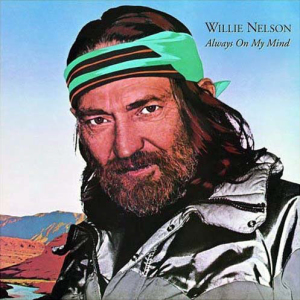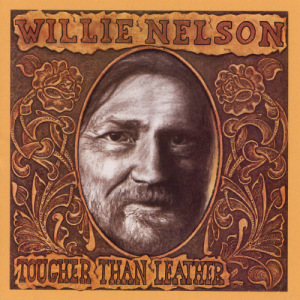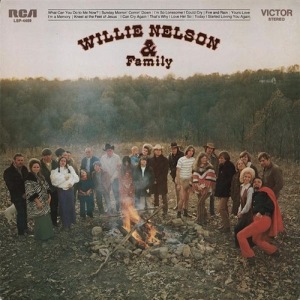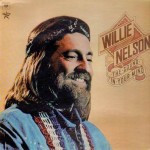 What follows is a collection of Willie Nelson‘s greatest recordings, organized as a virtual “best of” playlist that would fit on four CDs. Most of the big hits are here, plus overlooked deep album tracks and a few live versions. There is more to Willie than just what is presented here, but this at least gives a sense of the man’s talents. [Updated as of Oct. 2017]
What follows is a collection of Willie Nelson‘s greatest recordings, organized as a virtual “best of” playlist that would fit on four CDs. Most of the big hits are here, plus overlooked deep album tracks and a few live versions. There is more to Willie than just what is presented here, but this at least gives a sense of the man’s talents. [Updated as of Oct. 2017]
Disc 1:
- “Crazy” …And Then I Wrote (1962)
- “Family Bible” Yesterday’s Wine (1971)
- “Me and Paul” (1971); Yesterday’s Wine (1971)
- “Shotgun Willie” (1973); Shotgun Willie (1973)
- “Whiskey River” Shotgun Willie (1973)
- “Bubbles in My Beer” Shotgun Willie (1973)
- “Washing the Dishes” Phases and Stages (1974)
- “Walkin'” Phases and Stages (1974)
- “Bloody Mary Morning” (1974); Phases and Stages (1974)
- “Blue Eyes Crying in the Rain” (1975); Red Headed Stranger (1975)
- “That Lucky Old Sun (Just Rolls Around Heaven All Day)” The Sound in Your Mind (1976)
- “Can I Sleep in Your Arms?” Red Headed Stranger (1975)
- “I’d Have to Be Crazy” (1976); The Sound in Your Mind (1976)
- “If You’ve Got the Money I’ve Got the Time” (1976); The Sound in Your Mind (1976)
- Willie Nelson & Waylon Jennings – “I Can Get Off on You” Waylon & Willie (1978)
- “On the Road Again” (1980); Honeysuckle Rose (1980)
- “Mamas Don’t Let Your Babies Grow Up to Be Cowboys” The Electric Horseman (1979)
- “Georgia on My Mind” (1978); Stardust (1978)
- Merle Haggard & Willie Nelson – “Opportunity to Cry” (1983); Pancho & Lefty (1982)
- “Always on My Mind” (1982); Always on My Mind (1982)
- “Is the Better Part Over” A Horse Called Music (1989)
- “My Love for the Rose [track 1]” Tougher Than Leather (1983)
- “American Tune” Across the Borderline (1993)
- “Ou es-tu, mon amour?” Teatro (1998)
- “Matador” Spirit (1996)
- “I Never Cared For You” Single (1964)
Disc 2:
- “Hello Walls” …And Then I Wrote (1962)
- “Undo the Right” …And Then I Wrote (1962)
- “I Gotta Get Drunk” Crazy: The Demo Sessions (2003)
- “Columbus Stockade Blues” (1966); Country Favorites – Willie Nelson Style (1966)
- “The Party’s Over” (1967); The Party’s Over and Other Great Willie Nelson Songs (1967)
- “Yesterday [live]” Live Country Music Concert (1966)
- “Help Me Make It Through the Night” The Willie Way (1972)
- “Happiness Lives Next Door” Naked Willie (2009)
- “London” The Words Don’t Fit the Picture (1972)
- “A Penny For Your Thoughts” The Sound in Your Mind (1976)
- “Devil in a Sleepin’ Bag” (1973); Shotgun Willie (1973)
- “Uncloudy Day” (1976); The Troublemaker (1976)
- “Railroad Lady” To Lefty From Willie (1977)
- “The Healing Hands of Time” The Sound in Your Mind (1976)
- “Till I Gain Control Again [live]” Willie and Family Live (1978)
- “A Song for You [~live]” Honeysuckle Rose (1980)
- “Buddy” The IRS Tapes: Who’ll Buy My Memories? (1992)
- “Summer of Roses/December Day” Tougher Than Leather (1983)
- “We Don’t Run” Spirit (1996)
- “Good Hearted Woman [live]” A Classic & Unreleased Collection [Willie Nelson Live at the Texas Opry House] (1994)
- “Darkness on the Face of the Earth” Teatro (1998)
- “Beer for My Horses (with Toby Keith) [live]” Live and Kickin’ (2003)
- “Songbird” (2006); Songbird (2006)
- “You’ll Never Know” Let’s Face the Music and Dance (2013)
- “Rainbow Connection” Rainbow Connection (2001)
- “This Old House” Remember Me, Vol. 1 (2011)
Disc 3:
- Paul Buskirk and His Little Men Featuring Hugh Nelson – “Nite Life” Single (1960)
- “Man With the Blues” Single (1959)
- “Misery Mansion” Single (1960)
- “Permanently Lonely” Crazy: The Demo Sessions (2003)
- “One Day at a Time” Country Willie – His Own Songs (1965)
- “The Local Memory” Crazy: The Demo Sessions (2003)
- “Darkness on the Face of the Earth” Country Willie – His Own Songs (1965)
- “What Do You Think of Her Now” Crazy: The Demo Sessions (2003)
- “Seasons of My Heart” Country Favorites – Willie Nelson Style (1966)
- “The Last Letter/Half a Man [live]” Live Country Music Concert (1966)
- “Good Times”; Good Times (1968)
- “Pins and Needles (In My Heart)” Both Sides Now (1970)
- “Mountain Dew”; The Willie Way (1972)
- “Stay Away From Lonely Places” The Words Don’t Fit the Picture (1972)
- “Sad Songs and Waltzes”; Shotgun Willie (1973)
- Tracy Nelson – “After the Fire Is Gone” A Classic & Unreleased Collection (1994)
- “Red Headed Stranger” Red Headed Stranger (1975)
- “You Show Me Yours (And I’ll Show You Mine)” Willie Nelson Sings Kristofferson (1979)
- “Loving Her Was Easier (Than Anything I’ll Ever Do Again)” Willie Nelson Sings Kristofferson (1979)
- “Angel Flying Too Close to the Ground” Single (1980)
- “Just One Love” Just One Love (1995)
- “I Guess I’ve Come to Live Here In Your Eyes” Spirit (1996)
- Willie Nelson / Merle Haggard – “Somewhere Between” Django and Jimmie (2015)
- “(The) Most Unoriginal Sin” Across the Borderline (1993)
- U2 – “Slow Dancing (Feat. Willie Nelson)” If God Will Send His Angels Single (1997)
Disc 4:
- “Opportunity to Cry” Crazy: The Demo Sessions (2003)
- “Funny How Times Slips Away” …And Then I Wrote (1962)
- “Half a Man” Here’s Willie Nelson (1963)
- “Yesterday’s Wine”; Yesterday’s Wine (1971)
- “Crazy Arms” Both Sides Now (1970)
- “One Step Beyond” The Words Don’t Fit the Picture (1972)
- “Sister’s Coming Home / Down at the Corner Beer Joint” Phases and Stages (1974)
- “I Never Cared for You [live]” Live Country Music Concert (1966)
- “I Love You a Thousand Ways”; To Lefty From Willie (1977)
- “Time of the Preacher Theme [0:26]” Red Headed Stranger (1975)
- Willie Nelson & Waylon Jennings – “It’s Not Supposed to Be That Way” Waylon & Willie (1978)
- “Golden Earrings” Without a Song (1983)
- “Home Motel [Hotel]” The IRS Tapes: Who’ll Buy My Memories? (1992)
- “Pretend I Never Happened” The IRS Tapes: Who’ll Buy My Memories? (1992)
- The Highwaymen – “Pick Up the Tempo” The Road Goes on Forever: 10th Anniversary Edition (2005)
- “I’ve Loved You All Over the World” Teatro (1998)
- “The Maker”; Teatro (1998)
- “Spirit of E9″ ” Spirit (1996)
- “I’m Not Trying To Forget You Anymore” Spirit (1996)
- “From Here to the Moon and Back (with Dolly Parton)” from …To All the Girls (2013)
- “But Not For Me” Summertime: Willie Nelson Sings Gershwin (2016)
- Willie Nelson / Merle Haggard – “Django and Jimmie” Django and Jimmie (2015)
- “I’m a Worried Man (featuring Toots Hibbert)” Countryman (2005)
- “Why Baby Why” Remember Me, Vol. 1 (2011)
- “Heartaches By the Numbers” For the Good Times: A Tribute to Ray Price (2016)
- “Roly Poly” Here’s Willie Nelson (1963)



